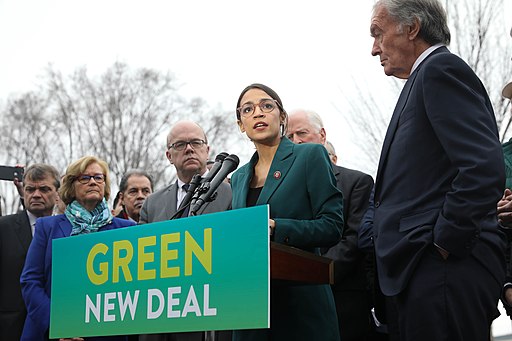Item Link: Access the Resource
Date of Publication: 2019
Author(s): Brian Czech
Newspaper: Steady State Herald
Originally published in Steady State Herald, 14 February 2019
Ask Americans what the Green New Deal is all about, and you’ll get two basic answers. Most often you’ll hear, “It’s about moving to renewable energy in order to fight climate change.” You’ll also hear, from a camp further right, “It’s all about socialism!”
Either way, the really green, really new feature is overlooked. What the Green New Deal is really about is the transition to a steady state economy. At least, that’s what it must be about, to be truly green and new.
Let’s start with green. “Green” connotes environmental protection. Some may view it naively as a tree hugger’s agenda, but ultimately, it’s about economic sustainability. That’s because economic activity starts from deep in the environment; namely with the agricultural and extractive sectors such as logging, fishing, and ranching. Only with agricultural and extractive surplus can we free the hands for the division of labor into manufacturing and service sectors. (Anyone thinking otherwise may kindly skip their meals until acquiring the necessary common sense.)
Now let’s take a closer look at the point that agricultural surplus—and therefore the rest of the economy—requires the green deal of environmental protection. Agricultural surplus takes soil, water, a stable climate, and plenty of space. If, for the sake of GDP growth, we use too much of that space and water for other activities, remove or erode the soil in the process, or destabilize the climate, the agricultural sector will decline. The rest of the economy will decline right along with it. “Down will come baby, cradle and all.”
In other words, the reckless pursuit—or even the systematic pursuit—of GDP growth will backfire like a canon plugged with cement. And that is exactly what is happening, albeit in slow motion (so far). Exceptions notwithstanding, soils are eroding, water supplies are dwindling, climate is destabilizing, and too much space is being robbed from the agricultural sector. This is the opposite of environmental protection, agricultural productivity, and economic sustainability. It’s the opposite of green.
So, we need environmental protection badly, and we need to pursue it quickly, if not for the sake of nature, then for the sake of the economy. We need the green in the Green New Deal. But no one should think that simply transitioning to renewable fuels will accomplish greenness. Not by a long shot. We are already committed to a “brown” 21st century and beyond. Loading up the atmosphere with greenhouse gases (and many other pollutants) has set us up for long-term ecological unravelling. Wholesale habitat disintegration, species extinction, unhealthy forests, shifting agricultural zones, and evolutionary chaos will take centuries and possibly millennia to sort out.
Not that anything resembling today’s “normal” will return. Polar bears will be gone, along with many other canaries in the coal mines. Half of Florida will be under saltwater, while the fresh waters of the Ogallala Aquifer will be depleted. Climate suitable for a wheat belt will be far north of the current American and Eurasian breadbaskets. There’s no guarantee the earth will retain a wheat belt or any type of grain belt.
The best hope for future centuries is that a new balance of nature—and a new economic equilibrium—is reached, and reached in a process that doesn’t starve, infect, or otherwise decimate billions of souls.
Read the complete article here.

